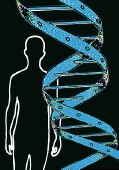- Skip Storing This Everyday Product in the Fridge Door
- Green Tea + B3 Pairing May Boost Brain Health
- Navigating Your Midlife Crisis: Embracing New Possibilities
- City Raccoons Showing Signs of Domestication
- Mapping the Exposome: Science Broadens Focus to Environmental Disease Triggers
- One Week Less on Social Media Linked to Better Mental Health
- Your Brain Changes in Stages as You Age, Study Finds
- Some Suicide Victims Show No Typical Warning Signs, Study Finds
- ByHeart Formula Faces Lawsuits After Babies Sickened With Botulism
- Switch to Vegan Diet Could Cut Your Greenhouse Gas Emissions in Half
Deciphering the DNA of Alzheimer’s Patients


Data that details every gene in the DNA of 410 people with Alzheimer’s disease can now be studied by researchers, the U.S. National Institutes of Health announced this week.
This first batch of genetic data is now available from the Alzheimer’s Disease Sequencing Project, launched in February 2012 as part of an intensified national effort to find ways to prevent and treat Alzheimer’s disease.
Genome sequencing outlines the order of all 3 billion chemical letters in an individual’s DNA, which is the entire set of genetic data every person carries in every cell.
“Providing raw DNA sequence data to a wide range of researchers is a powerful, crowd-sourced way to find genomic changes that put us at increased risk for this devastating disease,” NIH Director Dr. Francis Collins said in an institute news release.
“The [genome project] is designed to identify genetic risks for late onset of Alzheimer’s disease, but it could also discover versions of genes that protect us,” Collins said. “These insights could lead to a new era in prevention and treatment.”
As many as 5 million Americans aged 65 and older have Alzheimer’s disease, and that number is expected to grow significantly as the baby boomer generation ages.
Genome sequencing is considered a key strategy for identifying new clues to the cause of Alzheimer’s. The clues would come from differences in the order of DNA letters in Alzheimer’s patients when compared to people without the disease, according to the NIH.
The National Alzheimer’s Project Act, which became law in 2011, is meant to boost efforts to combat the disease. It calls for more research by both the public and private sectors, along with expanded access to clinical and long-term care. One of the first actions taken by the NIH under the act was funding a series of studies, including this genome-sequencing effort.
More information
The U.S. National Institute on Aging has more about Alzheimer’s disease.
Source: HealthDay
Copyright © 2025 HealthDay. All rights reserved.










